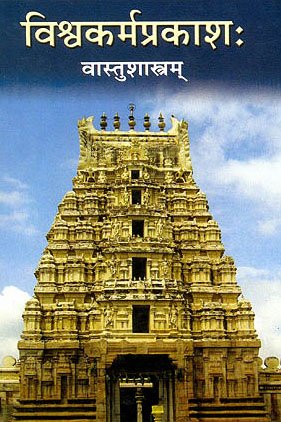Antargriha, Antargṛha, Antar-griha, Amtargriha: 13 definitions
Introduction:
Antargriha means something in Hinduism, Sanskrit, Marathi. If you want to know the exact meaning, history, etymology or English translation of this term then check out the descriptions on this page. Add your comment or reference to a book if you want to contribute to this summary article.
The Sanskrit term Antargṛha can be transliterated into English as Antargrha or Antargriha, using the IAST transliteration scheme (?).
In Hinduism
Vastushastra (architecture)
Source: OpenEdition books: Architectural terms contained in Ajitāgama and RauravāgamaAntargṛha (अन्तर्गृह) refers to “= garbkagṛha § 4.7.”.—(For paragraphs cf. Les enseignements architecturaux de l'Ajitāgama et du Rauravāgama by Bruno Dagens)

Vastushastra (वास्तुशास्त्र, vāstuśāstra) refers to the ancient Indian science (shastra) of architecture (vastu), dealing with topics such architecture, sculpture, town-building, fort building and various other constructions. Vastu also deals with the philosophy of the architectural relation with the cosmic universe.
Purana and Itihasa (epic history)
Source: archive.org: Shiva Purana - English TranslationAntargṛha (अन्तर्गृह) refers to the “inner apartments (of a palace)”, according to the Śivapurāṇa 2.3.47 (“The ceremonious entry of Śiva”).—Accordingly, as Brahmā narrated to Nārada: “Then the chief of mountains caused the investiture rite with the sacred thread for Pārvatī and Śiva with the Vedic hymns recited enthusiastically. Then Viṣṇu, the other gods and the sages entered the inner apartments (antargṛha) of the palace of the mountain enthusiastically at the request of Himācala. After performing the conventional rites in accordance with the Vedic injunctions and the social customs they decorated Pārvatī with the ornaments provided by Śiva. [...]”.

The Purana (पुराण, purāṇas) refers to Sanskrit literature preserving ancient India’s vast cultural history, including historical legends, religious ceremonies, various arts and sciences. The eighteen mahapuranas total over 400,000 shlokas (metrical couplets) and date to at least several centuries BCE.
Languages of India and abroad
Marathi-English dictionary
Source: DDSA: The Molesworth Marathi and English Dictionaryantargṛha (अंतर्गृह).—n (S) The inner apartments of a house; the cooking apartment, the hall, the gynæceum or seraglio &c.
Source: DDSA: The Aryabhusan school dictionary, Marathi-Englishantargṛha (अंतर्गृह).—n The inner apartments of a house.
Marathi is an Indo-European language having over 70 million native speakers people in (predominantly) Maharashtra India. Marathi, like many other Indo-Aryan languages, evolved from early forms of Prakrit, which itself is a subset of Sanskrit, one of the most ancient languages of the world.
Sanskrit dictionary
Source: DDSA: The practical Sanskrit-English dictionaryAntargṛha (अन्तर्गृह).—[antaḥsthaṃ gṛham &c.]
1) the inner apartment of a house, the interior of a house.
2) Name of a holy place in Benares; पञ्चक्रोश्यां कृतं पापमन्तर्गेहे विनश्यति (pañcakrośyāṃ kṛtaṃ pāpamantargehe vinaśyati).
Derivable forms: antargṛham (अन्तर्गृहम्).
Antargṛha is a Sanskrit compound consisting of the terms antar and gṛha (गृह). See also (synonyms): antargeha, antarbhavana.
Source: Cologne Digital Sanskrit Dictionaries: Shabda-Sagara Sanskrit-English DictionaryAntargṛha (अन्तर्गृह).—n.
(-haṃ) An inner apartment. E. antar within, and gṛha a house.
Source: Cologne Digital Sanskrit Dictionaries: Benfey Sanskrit-English DictionaryAntargṛha (अन्तर्गृह).—n. the inner apartments of a house, [Rāmāyaṇa] 2, 4, 3.
Antargṛha is a Sanskrit compound consisting of the terms antar and gṛha (गृह).
Source: Cologne Digital Sanskrit Dictionaries: Monier-Williams Sanskrit-English DictionaryAntargṛha (अन्तर्गृह):—[=antar-gṛha] n. interior of the house, inner apartment
Source: Cologne Digital Sanskrit Dictionaries: Goldstücker Sanskrit-English DictionaryAntargṛha (अन्तर्गृह):—I. [tatpurusha compound] n.
(-ham) The inner apartments of a house: the cooking apartment, the hall, the gynæceum &c. Ii. Avyayībh.
(-ham) In the interior of a house. Comp. antargeham. E. antar and gṛha.
Source: Cologne Digital Sanskrit Dictionaries: Yates Sanskrit-English DictionaryAntargṛha (अन्तर्गृह):—[antar-gṛha] (haṃ) 1. n. An apartment.
[Sanskrit to German]
Sanskrit, also spelled संस्कृतम् (saṃskṛtam), is an ancient language of India commonly seen as the grandmother of the Indo-European language family (even English!). Closely allied with Prakrit and Pali, Sanskrit is more exhaustive in both grammar and terms and has the most extensive collection of literature in the world, greatly surpassing its sister-languages Greek and Latin.
Kannada-English dictionary
Source: Alar: Kannada-English corpusAṃtargṛha (ಅಂತರ್ಗೃಹ):—[noun] the inner quarters of a house.
Kannada is a Dravidian language (as opposed to the Indo-European language family) mainly spoken in the southwestern region of India.
See also (Relevant definitions)
Partial matches: Griha, Antar.
Starts with: Antargriham, Antargrihayatra.
Full-text: Antargriham, Antargeham, Antarveshman, Samlagnika, Antargeha, Pracalaka, Antarbhavana, Koshtha.
Relevant text
Search found 2 books and stories containing Antargriha, Aṃtargṛha, Amtargrha, Amtargriha, Antar-gṛha, Antar-grha, Antar-griha, Antargṛha, Antargrha; (plurals include: Antargrihas, Aṃtargṛhas, Amtargrhas, Amtargrihas, gṛhas, grhas, grihas, Antargṛhas, Antargrhas). You can also click to the full overview containing English textual excerpts. Below are direct links for the most relevant articles:
The Skanda Purana (by G. V. Tagare)
Chapter 100h - Antargṛha Yātrā < [Section 2 - Uttarārdha]
Chapter 100 - Index to Kāśīkhanda < [Section 2 - Uttarārdha]
Chapter 55 - Ganeśa Proceeds on a Mission to Kāśī < [Section 2 - Uttarārdha]
Brihad Bhagavatamrita (commentary) (by Śrī Śrīmad Bhaktivedānta Nārāyana Gosvāmī Mahārāja)
Verse 2.3.112 < [Chapter 3 - Bhajana (loving service)]